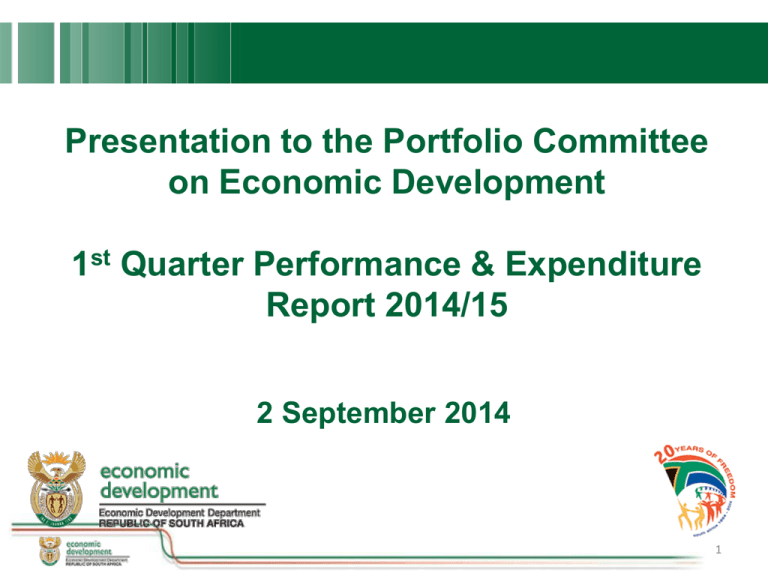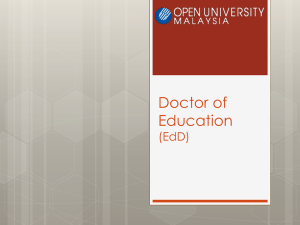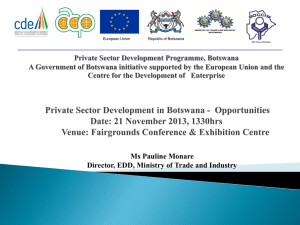Economic Development Performance Information
advertisement

Presentation to the Portfolio Committee on Economic Development 1st 1st Quarter Performance & Expenditure Report 2014/15 2 September 2014 1 Presentation outline • Background to the APP • Performance by programmes against APP KPIs • Transition to the new APP • Financials 2 Background to the APP • The first quarter of the 2014/5 financial year was a transitional quarter, falling between two Administrations • At the end of the fourth Administration and the start of the fifth Administration EDD reviewed plans and aligned them with the new electoral mandate • For EDD, this meant – Considerable time spent on working with other departments to develop the new MTSF, which now provides an integrated implementation plan for the NDP and its implementation framework in the form of the New Growth Path, National Infrastructure Plan and IPAP – Developing a new APP that sets out EDD’s tasks under the MTSF – Initiating a review of the structure of the department and staff re-alignment to meet the needs and demands that arise out of these new priorities – Starting a process of re-shaping the department to ensure we have the systemic and personnel capacities required for the new phase of our development 3 Implications for the APP • The APP is an annual plan used as to assess work against pre-determined outcomes • It never captures all of a department’s work, because – Changes in the economy and other factors may require unplanned interventions – The APP only includes high-level priorities • Managing the transition – The EDD initially tabled an APP in March 2014, under the fourth Administration – The Department then tabled a revised APP for 2014/15 in June 2014 to align with the MTSF and strengthen the focus on outcomes rather than processes – The new APP will increase the effectiveness of the Department in supporting job creation, inclusive growth and the coordination of economic policies and plans in line with the planning framework of the NDP and the implementation strategy of the NGP – The 2014/15 APP as tabled in June 2014 will need to have a reconciliation of work to take account of the Departmental activities undertaken prior to the new APP • This report therefore reports against the APP tabled in March 2014, but the next quarterly report will integrate activities for both quarters into the report using the June APP • We only report here on KPIs where a target was set for the quarter or relevant work was undertaken - KPI 6, 9, 10, 11, 13, 14, 24 and 30 had no planned outcomes for the first quarter 4 Programme 2 – Economic Policy Development Key Performance Indicator Q1 Target Q1 Actual 4. Number of Surveys and reports on the implementation of the New Growth Path 1 2 5. Number of platforms held to communicate and discuss issues related to the New Growth Path - 1 7. Policy interventions pursued and/or policy platforms held and/or impact reports completed to support inclusive growth and BBBEE 1 2 8. Sector interventions aligned, evaluated and improved 1 1 Under KPI 4: • A quarterly report on trends in inclusive growth, reviewing the targets set for Outcome 4 of the MTSF, was prepared for the Minister • The report noted that: – The GDP shrank marginally from January to March 2014, mostly due to the strike in mining that saw a substantial fall in platinum output. (Growth resumed in the second quarter to June, with a 1% year-on-year expansion in the economy in real terms) – Employment fell by 122 000 in the period to March, in large part due to seasonal factors (and 39 000 jobs were recovered from April to June, 2014) – The prolonged strike in the mining industry pointed to the importance of measures to address antagonism in the workplace; initiatives to address this have been included in the new MTSF as well as the EDD’s new APP 5 Economic Policy Development, cont. KPI 4 continued: • EDD proposed annual targets for Outcome 4 under the new MTSF, which were approved by Cabinet • The targets for which EDD is responsible include to: – Maximise the economic and employment impact of the build programme, through specific initiatives including driving local procurement and ensuring off-take plans so as to crowd in productive investment – Establish structures to ensure alignment across the state; and monitor progress and address blockages for the 10 drivers of the New Growth Path – Coordinate and improve the performance of economic regulators – Expand industrial financing and target it at priority sectors and activities, including township and youth-owned enterprises – Monitor prices to identify price shocks and develop appropriate response strategies – Identify unnecessary red tape and work to reduce it 6 Economic Policy Development, cont. Under KPI 5: • EDD hosted a conference on “Manufacturing-led growth for employment and equality.” This is in line with the EDD’s mandate to encourage a broad discussion on how to foster inclusive growth • The conference heard presentations on the theme from a number of leading academics, officials and stakeholders, including – Professor Gabriel Palma, an internationally renowned Latin American expert on industrial policy – The EU Chief Economist, Dr Francesco Caballero-Sanz – South African economists • It was attended by around 200 academics, officials and stakeholders, as well as academics from Mozambique, Zambia, Mauritius, Zimbabwe and other African countries • Over 30 papers were presented, with topics ranging from South Africa’s Super Exporters to industrial policy in the South African clothing sector and the interface between mining and manufacturing • EDD was able to source financing for the conference from a dedicated EU partnership facility, which provided R1,8 million for the conference, saving money for the Department in the process 7 Economic Policy Development, cont. Under KPI 7 • An analysis of employment, migration and growth trends by province was undertaken – The ending of apartheid brought major shifts in population, which affects planning for infrastructure and social services – The 2011 Census data point to much more rapid than predicted population growth in Gauteng and to a lesser extent the Western Cape • The population of Gauteng grew by 40% from 2001 to 2011, from 8,8 million to 12,3 million • The Western Cape population grew by 29%, from 4,5 million to 5,8 million • The population of the rest of the country rose by 7%, from 31,5 million to 33,7 million – The GHS and QLFS suggest that this trend has continued since 2011 – The mid-year population estimates however tend to underestimate internal – EDD will engage with Statistics South Africa on this in more depth, since the mid-term population data are used to allocate the provincial and local government budget shares 8 Economic Policy Development, cont. KPI 7 continued • EDD developed recommendations on the programme for radical economic change that forms part of the MTSF. • The programme includes: – Productive investment crowded in through the infrastructure build programme, driven by the PICC – Competitiveness enhancement in productive sectors of the economy, with sectoral strategies and improved responsiveness by economics departments in government and backed by a target of 75% local procurement as well as amendments to the Competition Act to address and counter monopoly pricing – Addressing spatial imbalances in economic opportunities, including measures to expand smallholder agriculture and employment and through densification of urban areas and improved commuter transport – Workers’ education and skills development to meet economic needs, including improved basic education, expanding post-secondary education and encouraging the in-migration of key skills – A macroeconomic and financial framework to support employment-creating growth including through counter-cyclical fiscal and monetary policies – Workplace conflict reduction and improved cooperation between government, business and labour, recognising that the roots of the conflict lie in deep inequalities, a lack of career mobility, and in some cases abusive supervisory practices 9 Economic Policy Development, cont. Under KPI 8: • An EDD research paper for the manufacturing conference analysed trends in employment, equity and growth in manufacturing, overall and by subsector • Key findings included: – Manufacturing share in total value added has fallen from 19% of the GDP in 2003 to 10% in 2013, though the value in real terms has gone up from R272 billion to R350 billion, in constant 2013 rand – The share of employment in industry in SA is at the norm for middle-income economies, but the share employed in agriculture is unusually low (6% compared to an average of 39%) – this is a clear legacy of apartheid – Although manufacturing output has grown, manufacturing employment has declined from 2008 – it is the only sector that has not grown jobs from third quarter 2010 - with job losses driven by commodity-based manufacturing (metals and wood/paper); only agro processing has seen employment gains since 2008 – Remuneration has grown as a percentage of value added in manufacturing, in contrast to the rest of the economy – Using the ILO’s measure of the ratio of the 90th percentile of earners to the 10th percentile, manufacturing is amongst the more inequitable sectors with a ratio of 19 to 1 – the ratio for the economy as a whole is 23, but that cross-sector comparison effectively compares domestic, farm and informal workers in the lowest percentiles with formal managers and professionals at the top – Skilled production workers in manufacturing are more likely to be non-African than in the rest of the economy – Concentration of ownership is high especially in resource-based sectors (petrochemicals and refineries) 10 Economic Policy Development, cont. KPI 8 continued • The Minister engaged with a number of companies in the labourintensive clothing and textiles industry to evaluate the impact of government programmes and identify additional requirements – Engagements took place with both employers and workers at Trade Core Investments Apparel (TCIA), Colibri, Peter Blond, Impahla Clothing and House of Monatic – It sought to identify the impact of IDC and government support in the sector, as well as export opportunities and import penetration – Investment and incentive support by government and its agencies was R5,1 billion in the sector over the past five years – Action on illegal imports was highlighted – in three years, government confiscated R1,8 billion in clothing and textiles imported illegally into SA • The Minister also launched a R25-million design centre at TCIA in Cape Town, part of a focus on improving fashion innovation in South Africa 11 Programme 3: Economic Planning Key Performance Indicator 12. Economic development initiatives facilitated and unblocked per year Q1 Target Q1 Actual 6 6 Under KPI 12: • Case Study – support for small enterprise: EDD provided support to Ms Boitumelo Taho, an informal perfume manufacturer, including – Showing her how to register her business as a company – Helping her analyse her costs – Introducing her to the Innovation Hub, which assisted her with quality control and packaging – This means her products are now being considered by major retailers • Case Study - action against illegal imports: EDD enabled Sesli Textiles, a major South African blanket manufacturer, to assist the Textiles Federation on illegal imports – Blankets are sometimes imported under incorrect tariff headings thus avoiding the payment of import duties – EDD facilitated collaboration between Sesli Textiles and the Textiles Federation, which had not been working together, to improve advice to SARS on the correct classification of imported blankets – As a result, Sesli has now joined the Textiles Federation and a constructive relationship has developed 12 Economic Planning, cont. KPI 12, continued: • Case study – supporting investment initiative: EDD is working with a Singapore company, Noble Resources, to develop a major soya processing plant in Lekwa in Mpumalanga – The plant will create 130 permanent jobs directly as well as thousands in growing soya and more in downstream processing of soya. This is separate from the construction jobs previously reported. – Over the past few years, EDD has supported it to obtain access to water and electricity, improved roads and sites – In the past quarter: • SANCO planned a picket for 24-26 June at the plant on issues of local employment; EDD facilitated a meeting between Noble, the municipality and SANCO that led to the picket being cancelled • The EDD also facilitated a meeting with the IDC and the Land Bank on getting black smallholders into the soya-processing value chain 13 Economic Planning, cont. KPI 12, continued: • Case study – facilitating agro-processing: The Sihlela Community Project proposed to develop 350 hector forestry plantation, with joint funding of R5 million from the IDC and Sappi, that would support 500 families. • The project was stalled because it needed a consent order from the DRDLR to shift land to forestry – The Minister brought the challenge to the attention of the Minister of DRDLR – After the DRDLR gave its consent, the IDC approved the required loan facility in the first quarter of 2014/15. 14 Economic Planning, cont. KPI 12, continued: • Case study – enterprise-level intervention to save jobs: EDD worked with the IDC and KZN-based Mediterranean Textiles on a restructuring project that aims to save industrial capacity and jobs – EDD facilitated discussion which released the Mediterranean Textiles property holding company from some of its guarantee obligations – The agreement allowed the owner of Mediterranean Textiles to buy back the factory and the building that houses it from the IDC – As a result, the company can be sold as a single unit, preventing its break up and the loss of jobs and organisational capacity. • Case study – improving relations with business: EDD mediated a dispute between an investor and the IDC, leading to a resolution – The investor and the IDC were in a conflict situation over the utilisation of an IDC loan – EDD facilitated a more constructive relationship that ended possible litigation that would have imposed greater costs on both parties 15 Economic Planning, cont. Key Performance Indicator 15. Provincial economic development plans and actions reviewed and feedback provided Q1 Target Q1 Actual - 1 Under KPI 15: • KwaZulu Natal and Limpopo requested the EDD to support their strategic planning sessions • Department officials assisted KwaZulu Natal in May 2014 and June 2014, and Limpopo in June 2014 • EDD helped identify how provincial plans could be better aligned with the NGP and also take advantage of national programmes, including the National Infrastructure Plan and the Spatial Development Zones • As a result of the engagement, the KZN representatives decided to include their entities in their APP, and they have requested EDD – To assist in developing a policy framework for oversight of their entities and – To provide a workshop to help with the shift toward outcome-based work • Insights from these sessions will inform the strategic engagements with the rest of the provinces 16 Economic Planning, cont. Key Performance Indicator Q1 Target Q1 Actual 16 18 16. Number of SIP construction progress reviews Under KPI 16: • The EDD monitors the SIPs for the PICC and Cabinet • EDD compiled 18 quarterly SIP reports for the January-March quarter of 2014 for the PICC, as part of the report prepared for Cabinet • Five site visits were conducted during the first quarter to June 2014 to enrich the SIP reports – Experience shows that site visits provide critical additional information – The site visits were to • • • • • Mahahane SP School, Cornubia Human Settlements, Spring Grove Dam, Ingula Pumped Storage Scheme and The New Multiple Product Pipeline • The Minister attended the sod-turning at the Mzimvubu Dam site in the Eastern Cape, following extensive engagement with the PICC and the Department of Water Affairs on the dam construction schedule • The EDD provided the 11th special report on progress on the SIPs to Cabinet Lekgotla in June 2014 – This was an in-depth analysis of projects and cross-cutting issues 17 Economic Planning, cont. KPI 16, continued: • EDD convened and provided assistance to PICC Secretariat and Manco meetings, including • • • • • • • meeting packs and documentation Identifying key blockages for consideration by the PICC Developing a records of decisions for Cabinet Preparation of discussion documents on key issues invitations to members of the structures Induction packs for new members, and follow-up of decisions. • In addition, during May 2014, the Minister provided a strategic overview of the Administration’s priorities and how it related to the build programme, to a meeting of the 18 SIP coordinators 18 Economic Planning, cont. Key Performance Indicator Q1 Target Q1 Actual 2 3 17. Number of infrastructure projects unblocked and / or fast tracked. Under KPI 17: • EDD engages pro-actively to unblock projects on behalf of the PICC • Case study: Hobhouse in Mantsopa in the Free State – A site visit was conducted by the PICC – It helped to unblock efforts to finalise a bucket eradication project – The technical quality of the system requires further work • Case study: Ngobi in Moretele in the North West – This is a Presidential Nodal Point Project identified as part of water and sanitation hotspots under SIP 18 by the PICC – The PICC mobilised Eskom to connect electricity to boreholes. – The boreholes have been commissioned and are functional. • Case study: Gibson Bay Wind Farm in the Eastern Cape – The wind farm will involve an investment of over R2 billion as part of the renewable energy independent power producer drive – It required authorisation under the Subdivision of Agricultural Land Act – The PICC, with support from DAFF, unblocked the application, enabling the wind farm to go ahead 19 Economic Planning, cont. Key Performance Indicator 18. Number of ministerial oversight engagements with the DFIs per year. Q1 Target Q1 Actual 1 1 Under KPI 18: • A Ministerial engagement was held with the IDC in June 2014 to identify key priorities of government and for the Minister obtain a report-back on IDC operations. • The meeting aimed in particular to clarify the strategic imperatives for the IDC arising from the new Administration and is one of a number of engagements planned to provide guidance and oversight of the DFI 20 Economic Planning, cont. Key Performance Indicator 19. Road shows marketing the products of sefa to SMMEs Q1 Target Q1 Actual 5 5 Under KPI 19: • EDD developed an integrated approach to supporting small business support across government to guide the work of agencies reporting to the Minister • It worked closely with sefa and the IDC to hold roadshows in every province • The roadshows enabled SMMEs to engage with sefa, seda and other agencies to understand their products • In the quarter under review, roadshows were held in Mpumalanga, the Western Cape and Polokwane, and at the ABSIO Youth Economic Indaba (Milpark) • The Minister participated in the roadshow in Delft, where he also met with Women in Construction to discuss opportunities arising out of the National Infrastructure Plan • A small business toolkit was produced by EDD and printed for a first-phase pilot (at a cost of R43 000) • The Minister convened a small business conference on 7 April that brought together hundreds of new or small entrepreneurs to engage with public agencies • The Minister opened the Shanduka Black Umbrella Enterprise Development Awards, which facilitate private support for SMMEs, in Cape Town on April 9 21 Economic Planning, cont. Key Performance Indicator 20. Value of financing facilitated for small businesses, targeted growth sectors and companies in distress Q1 Target Q1 Actual 1.25bn Disbursed: R3663m; approved : R2245m Under KPI 20: • The target set for industrial financing by the IDC and sefa was R1,25bn • In the period, they exceeded the target with disbursements of R3,7 billion and approvals of R2,2 billion • This is in line with the rapid expansion in industrial financing achieved over the past five years • The IDC funded 41enterprises in the first quarter of 2014/5, of which: – 21 were black empowered and 11 had at least 25% women ownership – 1 engineering firm had some youth ownership and a biomass company was headed by a young woman – 33 were in Gauteng, the Western Cape or KwaZulu Natal, with the rest in the North West, Mpumalanga, Limpopo and the Eastern Cape 22 Some IDC projects in the quarter Case study: building the clothing industry and jobs • Since 2011, the IDC has worked with a clothing enterprise that produces sports and leisure wear for an international brand. The company is South Africa’s first carbon-neutral clothing company. It has increased its employment from 190 to 431 in the past three years. • In this quarter, the IDC approved a R2-million facility that will be utilised for asset and working capital for the establishment of new manufacturing lines. As a result of this, the company plans to employ an additional five salaried and 35 waged employees. The Minister visited the plant. Case study: Supporting the construction industry • The IDC approved R7 million for an Eastern Cape manufacturer that produces a wide range of toughened glass for the construction and building industry. The company is a level-one BBBEE Contributor • The resources approved in this quarter will support production of insulated toughened glass in line with new energy-efficient regulations, while the other project will manufacture aluminium framed shower doors, windows and other such building materials. This will lead to the direct creation of 40 jobs. Case study: Youth enterprise • The IDC is supporting a young black woman to set up a factory to manufacture compressed biomass logs for braais and fireplaces. The logs will be manufactured from recycled waste and the factory will create 45 jobs. 23 Some sefa experiences Case study: Facilitating youth-owned enterprise • A wholly black and youth-owned enterprise was awarded a contract to build the primary school at Motaung in the North West. To cover its cash flow, sefa lent it R5 million, resulting in the creation of 130 jobs ranging from bricklayers to general labourers. Case study: The green economy for small enterprise • Sefa lent a company R4,8 million to establish production of a process to carbonise macadamia nut shells for use in filtering water and petroleum. The process generates bio-diesel as well as electricity for the farmers, so the cost of raw materials is offset and no fuel is needed for the process itself. Case study: Supporting black women in emerging business • Mpho Megalanyane started a printing business in Kimberley in 2010 and has invested in screen printing machinery and related equipment. She received an order to print 30 000 t-shirts, and borrowed R788 000 from sefa to cover materials. The project created work on a temporary basis for 24 people as well as two permanent jobs. 24 Economic Planning, cont. Key Performance Indicator Q1 Target Q1 Actual 21. Evaluative reports on jobs targets achieved by IDC and sefa, Competition Commission and Tribunal and ITAC 1 1 22. Ministerial oversight engagements with ERBs per year 1 1 Under KPI 21: • EDD is evaluating the impact of its regulatory agencies on job creation • A regular report is provided on this issue covering the Competition Commission and ITAC • For the first quarter of 2014/5, – ITAC measures led to companies committing to create or save over 100 jobs – Decisions by the Competition Commission on certain mergers in June saw 119 jobs saved Under KPI 22: • The Minister held three meetings with the competition authorities in June 2014 to discuss strategic issues arising under the new Administration; obtain feedback on the work and operations of the authorities; consider challenges raised by the authorities; and discuss possible legislative amendments. 25 ITAC achievements • ITAC published draft policy guidelines on scrap metal for comment • It finalised six investigations – Relating to reduced duties on graphite electrodes, stranded wire and cycling shoes – Increased duties relating to beadwire, vitreous enamels – Rebate application for plastic sanitary ware • It finalised anti-dumping investigation for soda ash and initiated one on wheelbarrows • It made a preliminary determination on frozen chicken portions • It completed sunset review on welded chain link • It issued 4615 import and 3351 export permits • It conducted 218 scheduled (i.e. related to a complaint) and 157 unscheduled investigations • It completed research on local manufacture of boats 26 Competition authorities’ achievements • Groundbreaking decision by the Tribunal on excessive pricing by Sasol for purified propylene and polypropylene – Commission had also found collusion between Safripol and Sasol, which the companies settled for R128 million – The Tribunal imposed an administrative penalty on Sasol of R534 million and directed Sasol and the Commission to submit a pricing remedy within 90 days that would reduce prices to consumers – Sasol is appealing the decision • In the first quarter of the FY, 110 mergers were notified. • • The Commission imposed conditions on eight cases, of which six addressed employment by placing moratoria on job losses for a two or three year period, protecting 1671 jobs. The other two cases, on concerning logistics companies and the other construction materials, contained remedies aimed at ensuring a competitive environment by limiting cross shareholding and potential information sharing between competitors. • Two search and seizure operations undertaken against companies for colluding to divide markets - Unilever and Sime Derby Hudson and Knight, for allocating markets for food oils and fats; and two panel beaters in collaboration with a vehicle accident assessment centre. • In Phase II of the construction investigation, a further settlement was reached with Harding Allison for colluding on a private-sector project in KwaZulu Natal 27 The Afgri agreement • Agreement was reached with Afgri as part of the Competition Commission’s review of a takeover by Agrigroupe, a foreign investor • The agreement required Afgri to undertake a variety of support measures for small farmers • From March, when the agreement was reached, to early July, Afgri has: – Spent R1,8 million on training at a dedicated site north of Pretoria – this will increase substantially to total R60 million over the coming four years – On-lent R8,4 million from the Land Bank to smallholder farmers (Afgri assumes risk on the loans) – will increase substantially in coming season – Provided 40% discount on storage to 150 farmers who stored under ten tonnes of grain – Purchased 14% of its poultry from smallholder farmers, to whom it provides extension and veterinary services as well as technical, feed and management support – Provided various forms of support to schools in rural areas – Provided a borehole for the informal settlement at Zama Zama in Tshwane 28 Economic Planning, cont. Key Performance Indicator Q1 Target Q1 Actual 23. Interventions in relation to ERB 1 1 25. Interventions to promote regional integration (research studies produced or company or sector supported ) 1 0 Under KPI 23: • EDD engaged with the Economic Regulatory Bodies (ERBs) on their security strategies and improving management of confidential data • This is important because much of the information used by the ERBs is commercially sensitive, and also as a matter of good governance Under KPI 25: • This KPI relates to spatial interventions. While actions were initiated, they could not be finalised in time, so no target is claimed for this quarter. • The Minister did, however, engage with manufacturers in Atlantis on 16 April to discuss constraints to growing manufacturing there. • EDD’s work with industrialists has already led to major new investments in equipment manufacturing in Atlantis 29 Economic Planning, cont. Key Performance Indicator Q1 Target Q1 Actual 26. Actions, meetings and/or reports to implement Local Procurement Accord 1 1 27. Interventions to grow the Green Economy and/or reports on the implementation of the Green Economy Accord 1 0 Under KPI 26: • Lodox produces cutting-edge full-body scanners that have been used extensively overseas • Key financing for this innovation was supplied by the IDC • The Minister of Economic Development helped Lodox to engage with the Gauteng Department of Health and the Minister of Health • After the normal procurement process, in the quarter under review the Gauteng Department of Health purchased 12 scanners at a cost of around R3 million each • The process included a launch of the scanners by the Minister at the Africa Health Expo at Gallagher Estate on 29 May 2014 Under KPI 27: • Initiatives to support the Green Economy were started but not completed in the period under review. 30 Programme 4: Social Dialogue Key Performance Indicator 28. Social dialogue engagements held to increase awareness of accords and other economic issues among social partners Q1 Target Q1 Actual 2 2 Under KPI 28: • The Presidential Youth Indaba Western Cape report back forum was successfully held on 10 April 2014 in Cape Town, with over 400 people attending • It created a platform to publicise the IDC and sefa youth resources and programmes, which set aside R2,7 billion for youth enterprise • Some achievements reported at the Indaba: – – – – – 900 000 students are in public universities, and 650 000 in FETs (up from 350 000 in 2010) Over the past two years, accommodation for more than 4200 students has been completed at universities, plus 500 lecture theatres, labs and other facilities; two new universities and 12 new campuses for FET colleges are under construction - the biggest new university and FET build in the past 30 years. Minister of Trade and Industry signed a directive requiring 80% of new jobs in Business Process Services to go to youth Gauteng Province procured goods and services worth over R425 million from youth enterprises impacting on a total of 5105 youth as of June 2013 On just ten projects with reports to the PICC to December 2013, youth employment rose by over 4000 from April 2013 • The EDD also briefed the Gauteng government on progress on the Youth Employment Accord 31 Social Dialogue, cont. Key Performance Indicator 29. Evaluative reports and strategies developed to improve implementation of accords Q1 Target Q1 Actual 1 2 Under KPI 29: • EDD has undertaken in-depth monitoring and evaluation of progress on youth employment initiatives under the Youth Employment Accord • The report for the third quarter of 2013/14 was finalised • Key findings included: – Youth employment has begun to recover, in large part because of growth in construction and retail - in March 2014, there were 150 000 more youth employed than in March 2013 – Considerable progress has been made in expanding youth participation in public employment schemes (the EPWP and CWP) – reaching close to half a million • In addition, a report on the implementation of the other social accords for the fourth quarter of 2013/4 was completed 32 Social Dialogue, cont. Key Performance Indicator Q1 Target Q1 Actual 1 1 31. Engagements at company / industrial cluster level to save or create new jobs Under KPI 31: • Case Study - facilitating funding and operations to create jobs – EDD facilitated funding for and sits on the steering committee of the Western Cape Furniture Cluster, which brings together small furniture producers to improve training and productivity. – The Western Cape Furniture Quarterly Cluster Initiative Steering Committee Meeting was held on 24 June 2014. – The Cluster manages a training programme. Phase 1 commenced in June 2014 with a total of 147 people from 19 companies. It focused on compliance training which included Occupational Health & Safety and Employment Equity. – The major output of the cluster process will be provision of on-the-job skills training in the furniture industry for 200 workers. 33 Social Dialogue, cont. Key Performance Indicator 32. Knowledge network sessions and / or publications to enhance public policy and strategy Q1 Target Q1 Actual 1 2 Under KPI 32: • The department hosted two small business knowledge network sessions on unlocking the economic potential of townships in the North West and the Eastern Cape with civil society, government officials and academics • The meeting focused on the need to improve the integration of township enterprises into formal value chains as well as to address the constraints on their development (infrastructure, market institutions, commercial and industrial sites) • Participants identified the main economic opportunities as participating in the supply chains of the mining houses in the North West and mohair producers in the Eastern Cape. The sessions then explored ways to access these supply chains. • Following the network sessions, the department has received requests to provide capacity building on township economy initiatives and locations; spatial planning alignment support; and green economy implementation support. 34 Social Dialogue, cont. Key Performance Indicator 33. Capacity building projects for social partners on the New Growth Path per year. Q1 Target Q1 Actual - 2 Under KPI 33: • Case study: Training on local chicken production – EDD arranged for Mthombo Agri-business Institute to provide training on improving indigenous chicken production process and flock management to small scale farmers in Nkandla, KZN. The training took place in April 2014. About 55 farmers, most of whom were members of co-operatives attended the training. – EDD conducted a needs analysis particularly in terms of cooperative's small scale farmers' preference - i.e. broilers and layers vis-a-vis indigenous chickens. EDD then arranged for Umthombo Agri-business Institute to offer the training free of charge. – An EDD official assisted in the role of programme director and facilitator. • In addition, EDD facilitated a project that will teach learners how to develop their own photo-voltaic systems to provide power to schools, with a pilot in a Sharpeville school. EDD brought together the Gauteng Education Department and an NGO to take the project forward. 35 Social Dialogue Key Performance Indicator 34. Initiatives on productivity, entrepreneurship and innovation at a sectoral and national level implemented Q1 Target Q1 Actual 1 1 Under KPI 34: • The Indigenous Chickens User-friendly Guide for small scale farmers is a booklet with illustrative pictures that EDD designed in collaboration with the Developing Poultry Farmers Organisation (DPFO) to assist small scale farmers in the rural areas to have something they can always refer to whenever they encounter challenges in managing their flocks. • • This booklet also provides tips on optimally utilize their land (chicken farming-veggie farming rotation). This booklet is distributed to indigenous chicken farmers in rural areas EDD made inputs on the content of the booklet, graphics and content alignment, as well as paid for the packaging of the booklet and the printing of the first 1000 booklets, for just under R40 000. • In addition, the Minister launched the Mitchells Plain Skills Centre in April, following technical support and premises supplied through EDD intervention. • • • The centre will provide training in upholstering, baking, gardening and entrepreneurship It also provides an enterprise incubator and co-ops training It has capacity to train 2840 learners and support 32 businesses 36 Programme 1: Administration Key Performance Indicator Q1 Target Q1 Actual 1. Number of management meetings 3 3 • Management meetings were held for each month of this quarter, in line with target • Recruitment of high-level posts was effectively halted to allow for restructuring by the incoming Administration based on the personnel and resource needs new MTSF. 37 Transition to the new APP • The work that was done by the department in this quarter was in line with the APP 2014/15 that was tabled in the 4th Administration • However, this work has been cascaded into the new APP 2014/15 that was tabled in the 5th Administration after the May elections. • All of the KPIs carried through into the APP tabled in June 2014 have been achieved. A separate report is being finalised on the work on these KPIs and will be provided to the Portfolio Committee once signed off. 38 Rea leboha! Siyabonga! Thank you! 39







